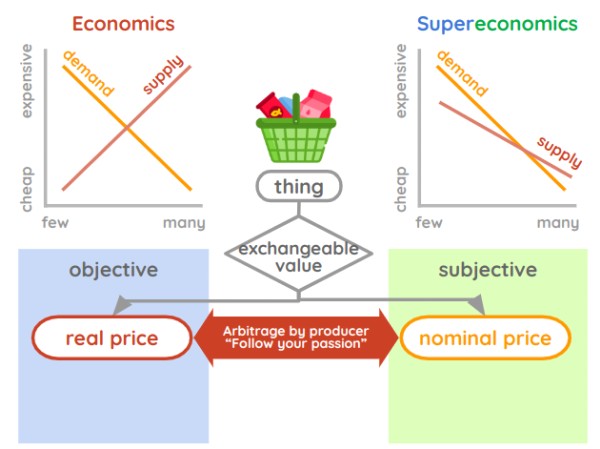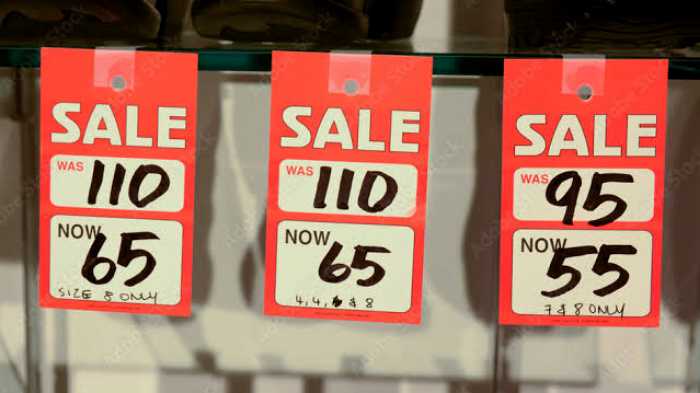Real Price
The Real Price is the subjective cost that the seller or producer incurred to create a thing.
Let us assume that a cake was baked by Mr. Chef for 2 units of effort.
To bake the same cake, it will take Arun, Bhaskar, and Chandra 4, 6, and 8 units of effort respectively. And so they each assign a real price of $4, $6, and $8 for the cake.

| Person | Effort | Cost (Real Value) |
|---|---|---|
| Chef | 2 | $2 |
| Arun | 4 | $4 |
| Bhaskar | 6 | $6 |
| Chandra | 8 | $8 |
Thus, Chandra is the worst at making cakes and so he values it the most at $8. This is to cover up:
- the ingredients he wastes
- his lack of knowledge on where to find the cheapest ingredients
Mr. Chef is the best at making cakes and so it costs peanuts to him at $2.
- He has an efficient kitchen setup and schedule
- He knows the cheapest and most reliable suppliers
Assume that Arun, Bhaskar, and Chandra need to buy a cake from Mr. Chef.
Mr. Chef then uses each sale from one cake as a capital to make the next cake (because his starting capital is only $2).
What market price should he assign?
Newbie Entrepreneur: $10 Cakes
If Mr. Chef overvalues his effort and sells the first cake at $10, then he will not be able to sell it. This is because Chandra will assign it a nominal value of $8 which matches his real value of $8.
At a market price of $10, all 3 men will make cakes themselves instead of buying it.
| Cake Market Price | Day 1 Buyers | Day 2 Buyers | Day 3 Buyers | Chef Revenue at the End | Cake Value Created | Unsatisfied Demand | Days Taken to satisfy all demand |
|---|---|---|---|---|---|---|---|
| $10 | no one | no one | no one | -$2 | $0 | 3 people | fail |
Entitled Entrepreneur: $8 Cakes
If Mr. Chef sells it at $8, then he can only sell it to Chandra. This will give him a net revenue of $6.
He can use the $6 to make 3 more cakes the next day.
But he finds that those 3 are unsold since Arun and Bhaskar cannot afford them. Instead, they make their own cakes.
| Cake Market Price | Day 1 Buyers | Day 2 Buyers | Day 3 Buyers | Chef Revenue at the End | Cake Value Created | Unsatisfied Demand | Days Taken to satisfy all demand |
|---|---|---|---|---|---|---|---|
| $8 | Chandra only @ $8 | no one | no one | $0 | $8 (1 cake) | 2 people | fail |
Socialist Entrepreneur: $2
Learning from this, he decides to sell it at cost or its Real Price. Note that this price includes the profit that he wants to keep on baking cakes.
If he sells it at $2, then he can only make 1 more tomorrow since his revenue is just enough to make 1 cake.
In this way, it takes him 3 days to satsify all demand.
| Cake Market Price | Day 1 Buyers | Day 2 Buyers | Day 3 Buyers | Chef Revenue at the End | Cake Value Created | Unsatisfied Demand | Days Taken to satisfy all demand |
|---|---|---|---|---|---|---|---|
| $2 | Arun | Bhaskar | Chandra | $2 | $6 (3 cakes) | none | 3 days |
Supereconomic Entrepreneur: $4
So through trial and error, he sets his market price to $4. In this way:
- his first sale will let him make two more
- all demand can be satisfied in 2 days
His net nominal revenue will be $4 in the end.
This can be used to export cakes to other towns to keep Mr. Chef employed and making cakes for everyone.
This system is the most efficient:
- there is nothing unsold
- all demand is addressed quickly
| Cake Market Price | Day 1 Buyers | Day 2 Buyers | Day 3 Buyers | Chef Revenue at the End | Cake Value Created | Unsatisfied Demand | Days Taken to satisfy all demand |
|---|---|---|---|---|---|---|---|
| $4 | Arun | Bhaskar, Chandra | demand satisfied | $4 | $12 (3 cakes) | all ok | 3 days |

Profit-Maximizing Entrepreneur: $6
Assume that the chef reads Neoclassical Economics, becomes selfish, and adopts profit maximization.
He will raise the cake at a higher market price of $6. This will:
- create 3 cakes on the second day
- 1 will be sold, leaving 2 unsold yet Arun would not be able to afford any of it
| Cake Profit-maximizing Market Price | Day 1 Buyers | Day 2 Buyers | Day 3 Buyers | Chef Revenue at the End | Cake Value Created | Unsatisfied Demand | Days Taken to satisfy all demand | |
|---|---|---|---|---|---|---|---|---|
| $6 | Chandra | Bhaskar | no one | $4 (2 cakes unsold) | $12 (2 cakes) | 1 person | fail |
This scenario leads to the same $4 net revenue. However, the drawbacks are:
- one customer is left unsatisfied
- there is an overproduction of 2 units
In the real world, this leads to price-cuts just to get rid of the unsold goods.

Let’s Compare the End Results
Assuming the Chef learns this pattern and is able to not overproduce, then the ending revenues will be:
| Chef | Cake Market Price | Chef Revenue at the End | Cake Value Created | Poverty of Cakes |
|---|---|---|---|---|
| Entitled | $8 | $8 | $8 (1 cake) | 2 |
| Profit-maximizing | $6 | $10 | $12 (2 cakes @ 2 days) | 1 |
| Supereconomist | $4 | $4 | $12 (3 cakes @ 2 days) | 0 |
| Socialist | $2 | $2 | $6 (3 cakes @ 3 days) | 0 |
From here, we can see that:
- The profit maximizer systemically gets the most revenue (most labor of society) at the cost of creating 1 unit of poverty
- The Supereconomist has less revenue than the profit-maximizer, but does not create poverty
- The socialist also creates no poverty, but takes longer than the Supereconomist. Also, there is no left over revenue to improve cake-making or do exports
Therefore, the profit maximizing system creates poverty where poverty could have been eradicated. This is so that it can have wealth and enjoyment for itself.
In the past, the poverty class would create crimes, insurrections, and rebellions to get their own needs addressed.
The profit maximizing system then learned to give dole outs to appease the poverty class.
In this example, they could take $2 from their revenue to address the poverty of cakes. Their revenue would still be more than the Supereconomist or Socialist systems.
In other words, the profit maximizing system propagates and supports dead weight in the economy to keep its own high revenue and inequality.
This means that from a total perspetive, a profit maximizing society, by keeping dead weight, is not maximizing its wealth and not advancing in the fastest and most efficient way possible.
The Solutinn: Know the Real Price of Everyone
The first solution is to know the real price of everyone so that the market price can be adjust to it.
This knowledge can be gained from the Effort Theory of Value.